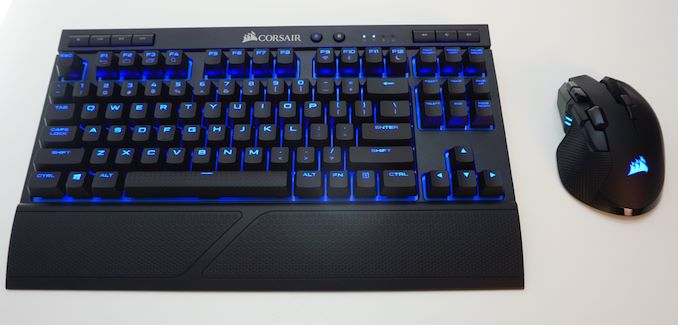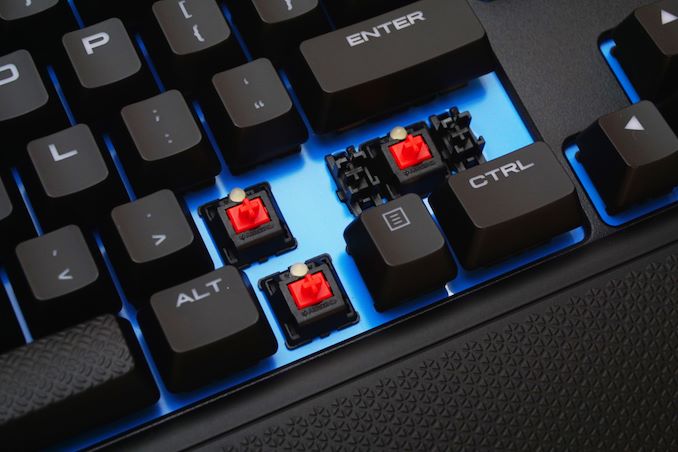The Corsair K63 Wireless Mechanical Keyboard Review: PC Gaming Untethered
by E. Fylladitakis on September 16, 2019 10:30 AM ESTConclusion
Corsair developed the K63 Wireless Mechanical keyboard primarily for living room gaming. And while, Corsair has made some trade-offs to get here, when combined with the optional Corsair Lapboard and a wireless gaming mouse like the Corsair Ironclaw, it forms an ideal setup for couch gaming. It can also be used as a wireless keyboard for a gaming laptop while connected to an external 5V power source or to another PC, making it particularly useful to users who want a desktop capable of switching between devices.
In terms of quality, the Corsair K63 is a well-designed, robust keyboard. Corsair mixed the design of the K65/K95 series with that of the Strafe with very good results, creating a solid and relatively lightweight portable mechanical keyboard. Cherry’s MX switches never disappoint, showing exceptional stability and quality over and over again. Aesthetically, the plastic-shelled keyboard certainly loses some points over the aluminum-based designs of the K65/K95 keyboards but, despite that plastic chassis, it remains elegant and ideal for modern desktops and living rooms. The real issue with the design of the K63 probably is the classic recessed keys area that, unlike flat designs with “floating” keys, traps dust and debris and requires frequent cleaning - an issue that will probably be bourgeoned during living room use.
With any wireless product – but especially one in a relatively new field like wireless mechanical keyboards – comes the question of battery life, and here Corsair's keyboard doesn't excel, but it does offer a reasonable compromise. On the whole, the K63's battery life is sufficient and it will easily last through daily gaming sessions, but at the same time it can't match typical wireless office keyboards, whose battery life of which is measured in months, or even years. With the backlighting disabled, you're looking at a few days of battery life, while enabling the beautiful-but-expensive backlighting will bring the K63 down to just a day of battery life.
Overall, the Corsair K63 is excellent quality product, but it is not a keyboard for everyone. Corsair made a gaming-focused keyboard with the K63, and that's certainly where it shines. The tenkeyless design is a trade-off in and of itself, but unless you need it for gaming, then the small size of the keyboard can enhance a gamer’s experience by improving mouse handling and space. On the flip side, however, this isn't a portable version of Corsair's most advanced keyboards – it's a K63 rather than a K95 for a reason – so gamers looking for the most advanced keyboard on the market may find the keyboard coming up short. In particular, the limited number of keys may constrain gamers who are used to having a great number of macros and other advanced functions.
Meanwhile, office/productivity users will want to look elsewhere entirely. The trade-offs made for a gaming keyboard don't make as much sense for general use, especially with the lack of a numpad.
As for portability, the K63 is a reasonably small keyboard; but it is not quite small and lightweight enough for frequent transportation. This goes hand-in-hand with the battery life of the keyboard, which although is reasonable for the segment, it is still is measured in days, making it better than a smartphone, but worse than something like a game controller.












75 Comments
View All Comments
Marlin1975 - Monday, September 16, 2019 - link
Still more MicroUSB devices/cables/etc... that C right now. Be dumb for Corsair to go after a smaller market and limit themselves.Type C will take over eventually, but not over night.
TheinsanegamerN - Monday, September 16, 2019 - link
USB C came out 4 years ago. Most new android phones today use usb C outside of budget models.Dont make excuses for them. Type C is here, now. There is no reason to use microUSB over type C unless you are lagging 5 years behind the competition. This would be like releasig a parallel CD ROM drive in 2004, years after USB became universal.
They should have used type C in something this price.
Marlin1975 - Monday, September 16, 2019 - link
USB-C is still a mess and barely getting better. Don't take my word for it, there are plenty of reviews/reports that go into it.https://www.androidauthority.com/state-of-usb-c-87...
Its why so many new phone, laptops, etc... still use MicroUSB.
DanNeely - Monday, September 16, 2019 - link
The mess of mutually incompatible fast charging standards barfed on top of USB is a cluster on micro-b too; not something new for C. For a keyboard with a small battery and presumably a simple battery controller it's almost certainly a moot point with no fast charging modes being supported. Stacking thunderbolt, and multiple optional video output options on top of basic data is irrelevant for a keyboard.Meanwhile reversible plugs being easier to use, and the USB-C socket being stronger than the micro-B one are very relevant; especially since the rear location of the charging port means a lot of people will be trying to plug it in blind.
OTOH if this is a 2016 model not having C isn't that surprising since it was a fairly avant-garde feature at the time.
catavalon21 - Monday, September 16, 2019 - link
It's not that old. It was announced at CES in January 2018, and reviews all over the Net started in the months after that.Korguz - Monday, September 16, 2019 - link
" Don't take my word for it " based on your previous FUD comments, dont worry :-)Lord of the Bored - Tuesday, September 17, 2019 - link
Except back in 2004, compatibility and support for older hardware was a thing people concerned themselves with.If some barbarian needed an external CD drive, it was almost certainly for a laptop, and even odds if their machine even had USB ports. (The smart money would've been a CD-ROM with a PC Card interface, but I don't think anyone ever actually shipped those.)
piiman - Saturday, September 28, 2019 - link
Go buy an adapter thensnowmyr - Monday, September 16, 2019 - link
I would imagine when most people complain about not having usb type C they are probably just referring to the micro-usb end only.I have a ducky keyboard with micro usb and of course i could't care less that the cable attaches to the keyboard that way considering it's a wired keyboard and i don't plan on ever removing it.
For a wireless keyboard that cost a fair amount of money... well there is the hardware failure point for most of them one day.
dan82 - Monday, September 16, 2019 - link
I wish Type A would die as well, but I pointed out microUSB because for an accessory the device side is more important given that you can always swap out the cable. And also, microUSB feels more legacy than Type A, given how Android embraced it years ago on their phones.Type A is going to stick around for a long time unfortunately. No company sells a real Type C hub (as opposed to a connect-your-legacy-devices-hub). Heck, even Tesla still puts it in its cars. I’m pretty pessimistic there.